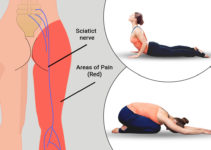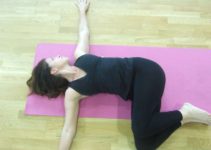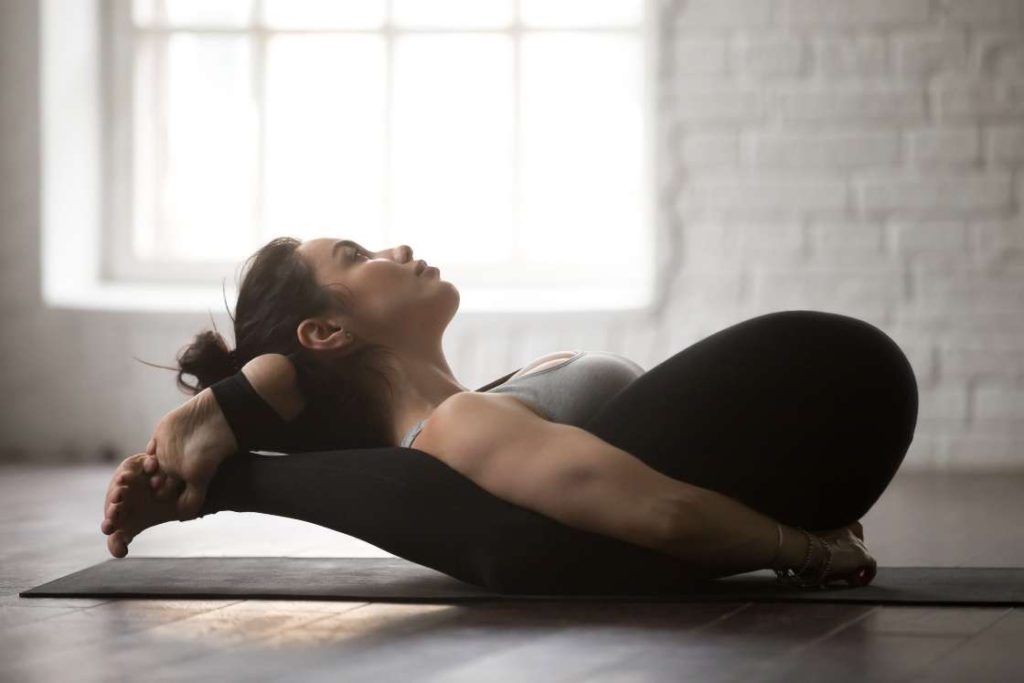
| Sanskrit Pronunciation | Yoganidrasana (YoG-AA-nid-RAA-sa-nuh) |
| Meaning | Yoga = unite / nidr = sleep / asana = pose |
| Pose Type | Reclining forward bend |
| Pose Level | Advance pose |
| Anatomy | Back muscles, hips, hamstrings, inner thigh, calves, neck, pelvis, and chest |
| Other Names | Leg Behind-Head pose, Yoga Sleep Pose. |
Yoganidrasana is called the pose of a sleeping yogi. You can consider it as the sleeping position of a yogi.
Yogic sleep pose is a reclining forward bend in which you place both the legs behind your head so the torso comes in between the thighs. However, it’s a relaxing pose but it deeply stretches the hamstring and lower back muscles.
It’s a widely practiced pose in the ashtanga yoga tradition. It mainly works on strengthening and flexibility of hips, lower back, spine, and inner thighs physically.
Yoganidrasana Meaning
Yoganidrasana is a Sanskrit term that can be translated as ‘Yoga’ means ‘to unite’, ‘Nidra’ means ‘sleep’ and ‘asana’ means ‘posture’. Therefore, in this asana, the practitioner resembles the sleeping yogi by being in the asana. However, the practitioner remains aware of him and his surrounding throughout the practice.
In yogic sleep pose, practitioners walk down into the realm of their immense individuality that keeps their insight to rest upon and experience calmness.
On termination of every Yuga (Era), the ocean transforms into the bed of the lotus navel, on which the preserver of the Universe Vishnu, The Hindu deity, will enjoy the deep sleep under the spell of spiritual meditation.
Mahabharata Book 1, section 21
Yoganidrasana pose is not for normal sleep that we all have after an exhaustive day to recharge our body for another day. It is finer in approach and vast in context. Also, yogic sleep pose shouldn’t be equated with basic yoga poses for sleep which is comparably easy.
Because it has in-depth philosophical meaning in this pose, the practitioner performing Yoganidrasana on regular basis experiences the highest of bliss. It becomes the spiritual meditation if one centralized all of their awareness within them.
Yoganidrasana is described in the 17th century Hatha Ratnavali and also illustrated in an 18th-century painting of the 8 yoga chakras in Mysore.
Practice Guide
Practitioners can follow the below step-wise step direction for the safe practice of Yoganidrasana.
Contraindications for Yogic Sleep Pose
- Practitioners with the condition of High blood pressure should avoid doing this asana as it might raise the blood pressure, which would be fatal.
- Women with pregnancy should refrain from doing Yoganidrasana. The forward deep bend is inappropriate for the fetus than the mother carries.
- People with a condition of hernia, lower back, shoulder, and knee injury should not perform this asana. As it might worsen the condition on further stress.
- Patients who have undergone any kind of surgery concerning the body parts participating n the Yoganidrasana also avoid until or unless recovered fully.
Preparatory Poses
How To Do Yoganidrasana (Steps)
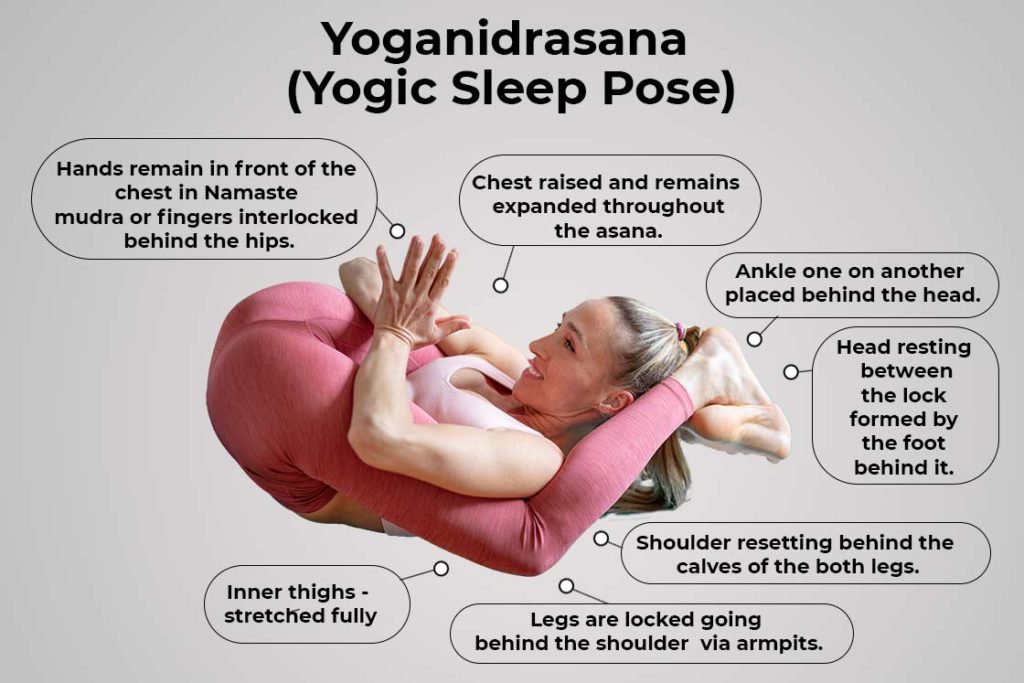
- Begin by coming into the Shavasana (Corpse Pose). Hands beside the hips and feet placed 1 to 2 feet distance apart and breathe slowly here.
- Now, bend both of your knees and bring your both feet in the vicinity of your hips. Hands remain still here as well.
- After that, grab your feet by both of your hands and pull them back near the chest. Your knee flexibility helps here in twisting the leg more toward the chest.
- Now, lift your shoulder along with the head from the floor and take your left leg behind your shoulder. In a manner that your left calf touches your left shoulder blade.
- After that, bring your right foot to the chest by twisting the knee and take the right leg behind the right side of the body.
- Now, interlock your ankle one on another and rest your back of the head on it. Place your armpit on the inner thigh of both legs and make a Namaste mudra or you can also interlock fingers behind your hips.
- Remain into the posture for as long as it is comfortable and then return to the normal position by unlocking the heels one by one slowly. Then relax.
Follow Up Poses
- Halasana (Plow Pose)
- Supta Matsyendrasana (Supinal Spinal Twist)
- BaddhaKonasana (Bound Angle Pose)
Precautions
Keep these precautions points in mind while doing yogic sleep pose;
- Practitioners should bend the knees slowly to prevent any mishappening. Do not force the bending of the knee if you’re unable to set the leg in the required position.
- Avoid heavy or deep breathing during the Yogic sleep pose. Forward bending might interrupt the contraction and relaxation of the diaphragm. Therefore, one should follow shallow and slow breathing.
- Practitioner on the completion of this asana should shift their attention in maintaining an upraised posture by expanding the chest rather than becoming lethargic and dropping your body.
Yogic Sleep Pose Beginners Tips
- Beginners with stiffened inner thighs and hamstrings should go slow and cozy with the yogic sleep pose. It requires good flexibility in the concerning muscles. So, focus on getting flexibility before enrolling in this asana.
- Beginners should not try to win this pose in one go. They should maintain a regular pace with the preparatory asana given above first to mend the lack ness required in Yoganidrasana.
- In case of the less movability of the knee joint, practitioners proceed with working on the knees via stretching or other means that helps in enhancement of the range of the knee movements.
Modifications
You can modify the yogic sleep pose by using the simple yoga props;
- Place a folded blanket under your head to block the direct contact from the ground in case you feeling pressure on the vertebrae while chest upraising in the complete yogic sleep pose.
- In order to keep the leg behind the shoulder for longer, one can bind the legs with the help of a yoga strap. It will prevent the returning back of the leg in Yoganidrasana.
- Practitioners who are unable or having difficulty in raising their head upward can practice this asana against the wall to rest head upon it. However, one can take the help of a second person as well to assist the posture.
Variations
There are two variations of yogic sleep pose, One Leg Behind Head Pose and Two Legs Behind Head Pose.
You can practice following variations in preparation to get into the final yoganidrasana;
1. Ek Pada Sirsasana (One Leg Behind Head Pose)
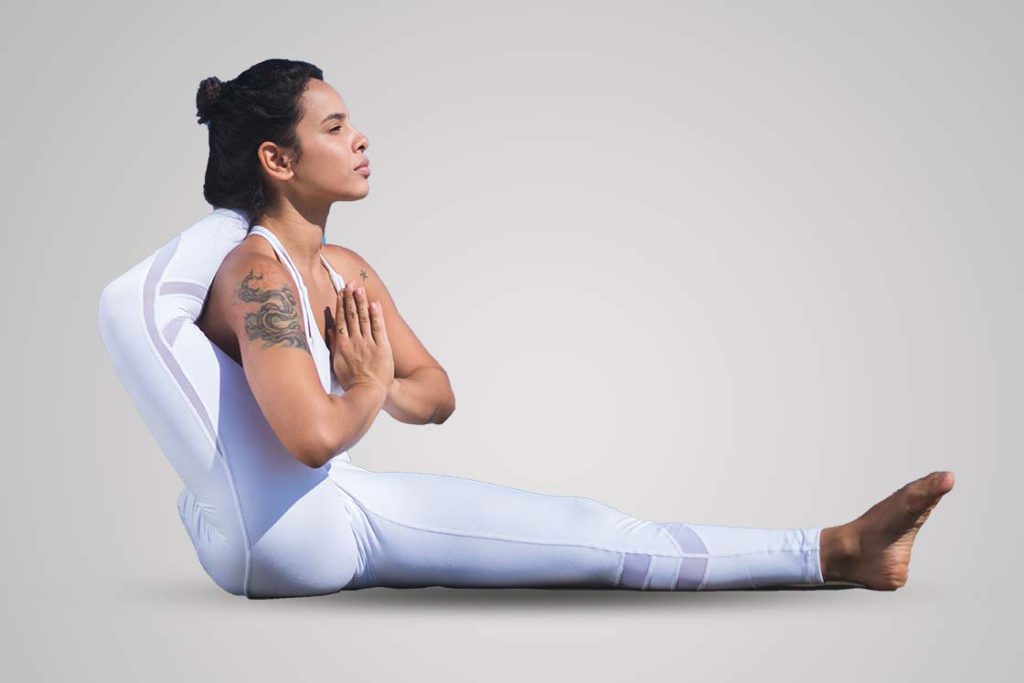
In Ek pada sirsasana, the practitioners place their either of the leg behind the neck while being in the sitting position (say Dandasana). Hands position can be in namaste mudra and behind the hips in the former asana but in the latter, it will always remain in the namaste mudra in front of the chest.
- Come into Dandasana, your legs stretched in front of you and hands placed beside the hips.
- Now, lift your left leg and place it parallel to the right knee. After, drop your left knee to the left side.
- From here, perform up and down movement to open up your hips and settlement of your posture on the hip bone.
- Now, bring your left near to the chest by grabbing the sole of the foot with both of the hands. Try to hug your shin bone here as well to get a good grip over the leg.
- Afterward, lean forward so that your shoulder comes down and place your left leg behind the neck. In this position, keep your right leg straight and join your hand to make a Namaste mudra in front of the chest.
- Maintain this posture for few seconds and then drop your leg down by leaning forward. Perform the same sequence with your right leg as well to complete the practice, and then rest.
2. Dwi Pada Sirsasana (Two Legs Behind Head Pose)
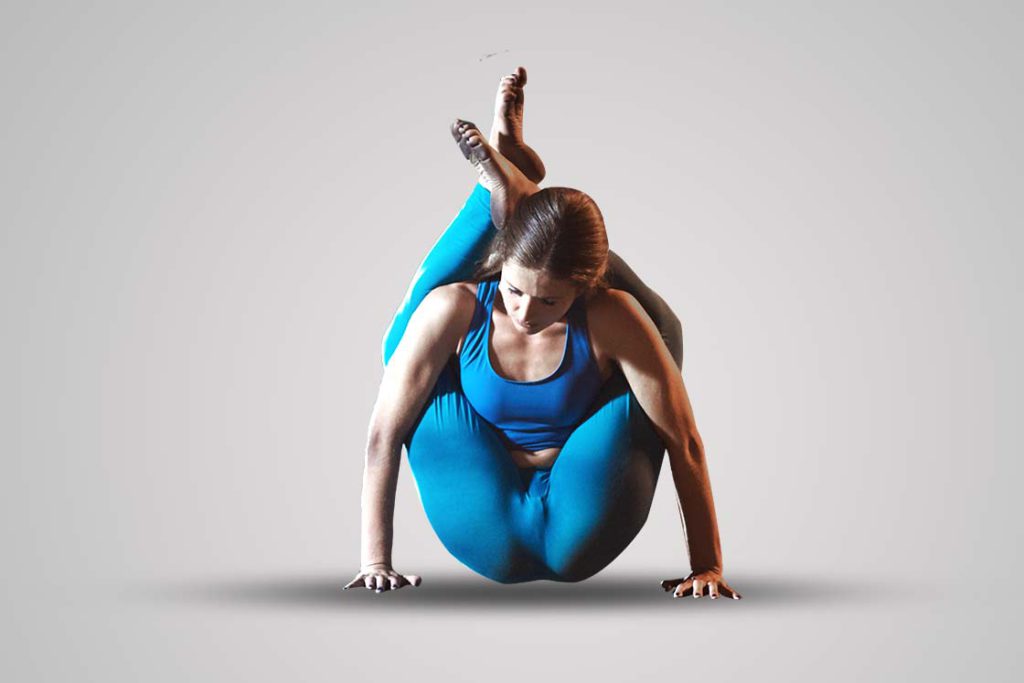
In Dwipadasana, both of the legs need to be placed behind the head while the hands remain on the floor for either balancing or near the chest in namaste mudra. Whereas in Yoganidrasana also both the legs remain behind the head but the body remains to lie on the floor. Hands either be placed behind the hip or placed in front of the chest in namaste mudra.
- Begin by coming into Dandasana where your legs remain straight and feet align together. Your hands are placed beside the hips and your back should be erect.
- Now, lift the left leg and place it parallel to the right knee and drop the left knee to the left side of the body.
- After that, bring your left foot close to your chest by grabbing the sole of the foot. Drop your shoulder down to wear your left leg like a shirt and then tuck it behind the head.
- Similarly, bring your right leg close to your chest and by balancing your body with one hand place your right foot behind the left foot. Make sure you lean a bit more in taking the second leg behind the head due to the presence of the left foot, which makes it challenging to place the second leg.
- Now, place your both hand on the floor to balance the body in case of intermediate practitioners. However, advanced practitioners can join their hands in namaste mudra right in front of the chest.
- After maintaining the pose for some time unlock the feet one by one and return to the dandasana. Then relax.
Yogic Sleep Pose Benefits
Apart from physically stretching the leg and back muscles, yogic sleep pose is beneficial for mental and emotional wellness. It allows the body to find its place or settle the mental and emotional aspects in a state of calmness. This further cultivates well-being and prosperity to re-established the outer framework in the life of the Practitioner’s life.
1. Strengthens Legs Muscles
The stretching in Yoganidrasana causes muscles to contracts and relax on practice, which lays stress on the muscle fiber. Such practice on regular basis raises the muscle like hamstrings, calves, and glutes and ultimately adds to strengthening.
2. Improves Blood Circulation
The entire body of a practitioner remains actively involved which makes muscles demand more supply of oxygen and nutrition on a continuous basis. Therefore, all the necessity is fulfilled by the enhanced blood circulation. Moreover, the raised blood circulation also acts as a detoxifier for various muscles of the body.
3. Promote Digestion
The deep forward bend in Yoganidrasana lays pressure on the abdomen region, which further massages the digestive organs. This results in better functioning along with the eradication of various digestive disorders. In this way, it helps in ensuring the digestion human body.
4. Activates Adrenal glands
In an attempt to place both feet behind the head in this asana the inner thighs put pressure on the place where the adrenal glands sit on kidneys. It improves blood circulation in the regions of concerning glands, which on a daily such experience becomes activated and secretes its secretion into the bloodstreams. This further regulates the metabolism of the body and promotes various health aspects.
5. Regulates stress and Anxiety
Workloads and busy lifestyles commonly cause stress and anxiety in various intensities, which if not treated well could cause a serious mental condition.
However, Yoganidrasana is designed in a way that on practicing it sets up a deep sense of relaxation in the body, which not only limits itself up to the physical scale but absorbs throughout the psychological aspects.
6. Stimulates Sacral Chakra
The appropriate practice of yogic sleep pose along with right breathing technique awakens the prana flowing in the subtle channels (nadis). This further leads to the stimulation of Svadhishthana (Sacral Chakra), which brings procreation, creativity, movement, successful relationships, and pleasure in the life of a practitioner.
Conclusion
Yoganidrasana is an effective approach to deliver a space filled with relaxation, happiness, health, and wellness that rebuild the mental, emotional and physical structure of human beings.
Practitioners going through a hard phase of life should once enroll themselves to see the difference in their life.

